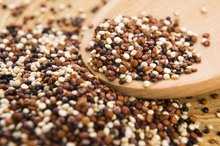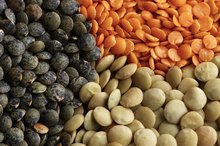Balanced Diet Food List
Eating a balanced diet is important for maintaining an optimal weight and protecting your long-term health. The U.S. Department of Agriculture dietary intake recommendations include foods that fall into five categories. Selecting foods from each of these groups will ensure you are eating a nutritionally complete diet.
Pick Up Some Protein
The ChooseMyPlate.gov website recommends that adult women eat 5 to 5 1/2 ounces of protein per day and that adult men eat 6 to 6 1/2 ounces per day, with 8 ounces per week coming from seafood. You can get your protein from a variety of sources: lean meats, such as beef and pork; poultry, such as chicken and turkey; fish, such as salmon and tuna; soy products such as tofu; and legumes, such as lentils and kidney beans. Seeds such as flaxseeds, chia seeds and pumpkin seeds also provide useful amounts of protein.
Go for Grains
List of Grains With Low GI
Learn More
Grains can provide a significant part of your daily carbohydrate and fiber intake. Women should eat 5 to 6 ounces per day, and men should have 6 to 8 ounces, with at least half being whole grain. There are a variety of options here: whole-grain bread and pasta, oats, brown rice, bulgur, rye and sorghum. Bran flakes, cereal flakes and muesli also fall into this category.
Dip Into Dairy
Dairy products provide an important selection of micronutrients, including calcium, potassium and vitamin D. ChooseMyPlate.gov recommends adults eat 3 cups of low-fat or fat-free dairy foods each day -- full-fat dairy can be high in saturated fat, which can be unhealthy in large amounts. In the dairy group, you'll find milk, yogurt and the whole range of soft and hard cheeses. Wherever possible, choose options with no added sugar.
Feature Some Fruit
Which Fruits Are Low in Potassium?
Learn More
According to ChooseMyPlate.gov, you can get your daily fruit intake from fresh, frozen, canned or dried fruits as long as they don't have sugar and other ingredients added. Women should aim to eat 1 1/2 to 2 cups of fruit per day, while men should aim for 2 cups. Fruit contains essential vitamins, minerals, fiber and antioxidants. Wherever possible, select local seasonal fruits for the greatest nutritional benefits.
Vary Your Vegetables
Vegetables also provide important micronutrients and fiber. There are five different groups of vegetables, based on their nutrients or color, and you should aim to "eat the rainbow" -- choosing a selection of vegetables from each of the color groups. Women should eat 2 to 2 1/2 cups per day, and men should eat 2 1/2 to 3 cups. Choose locally produced, in-season vegetables wherever possible. Dark green vegetables include broccoli and spinach; starchy vegetables include potatoes and corn; red and orange vegetables include carrots and tomatoes; beans and peas include lentils and kidney beans; while "other" vegetables include asparagus, avocados, eggplant and mushrooms.
Related Articles
Writer Bio
Lau Hanly runs Fierce For Life, a nutrition and fitness company that helps young women start with healthy eating and smart training without overwhelming them. She has a certificate of nutrition, and provide individual coaching, standard fitness and nutrition programs, and group training.









